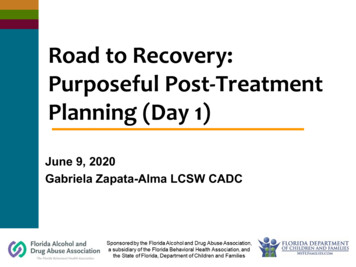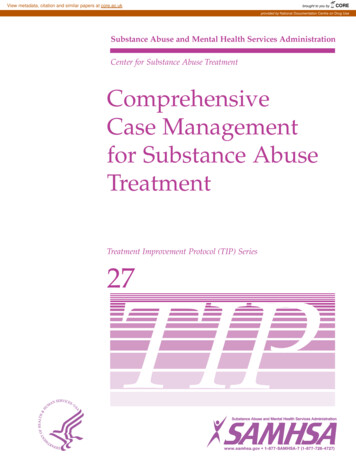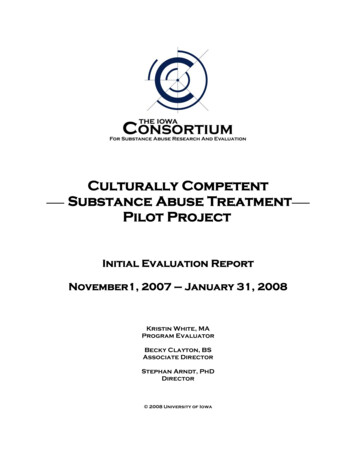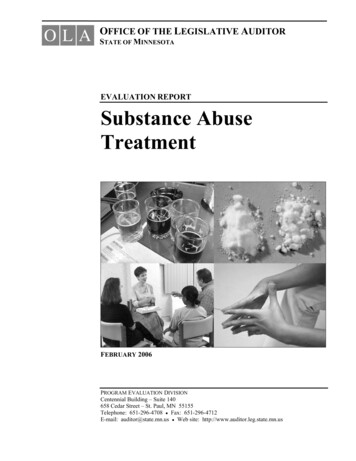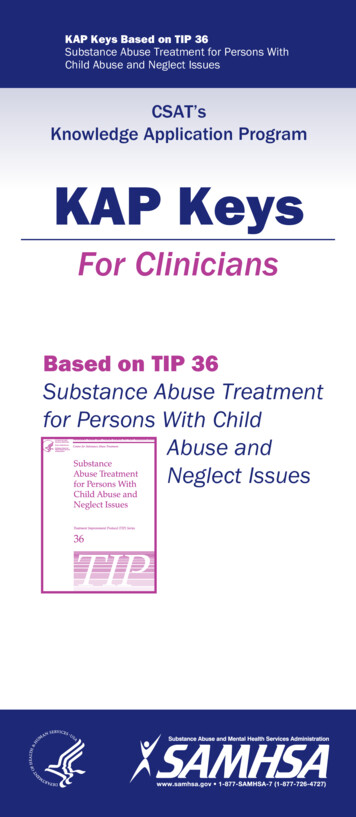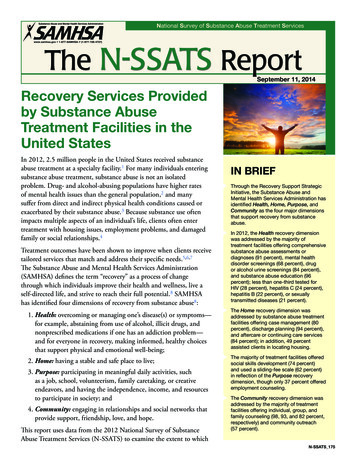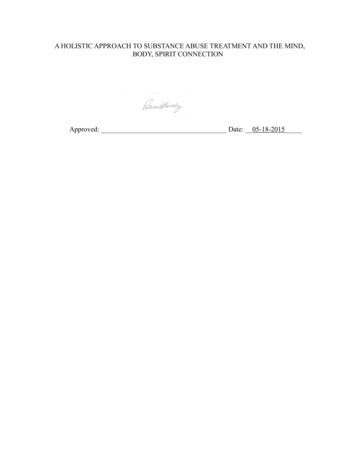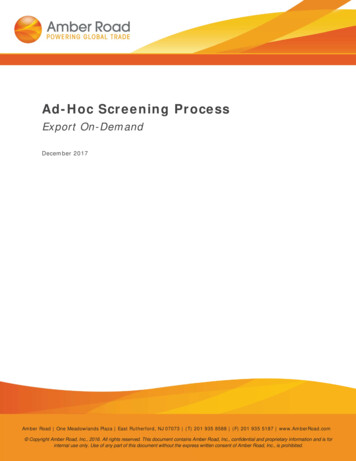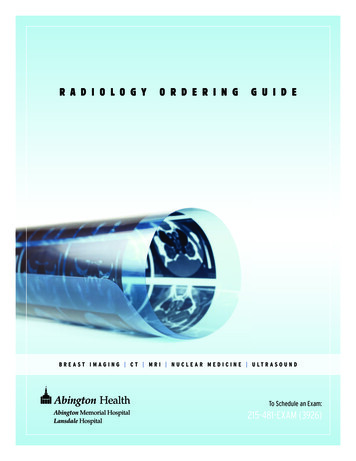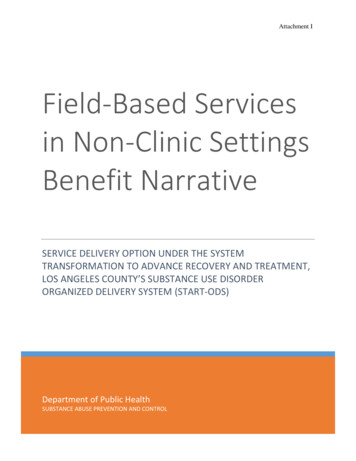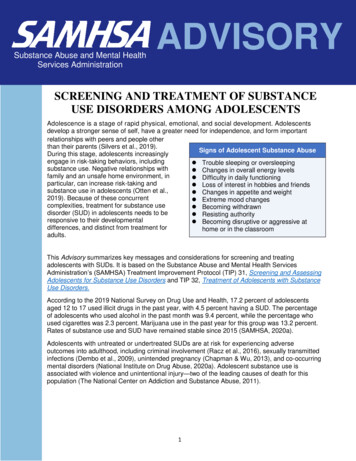
Transcription
Substance Abuse and Mental HealthServices AdministrationADVISORYSCREENING AND TREATMENT OF SUBSTANCEUSE DISORDERS AMONG ADOLESCENTSAdolescence is a stage of rapid physical, emotional, and social development. Adolescentsdevelop a stronger sense of self, have a greater need for independence, and form importantrelationships with peers and people otherthan their parents (Silvers et al., 2019).Signs of Adolescent Substance AbuseDuring this stage, adolescents increasinglyengage in risk-taking behaviors, including Trouble sleeping or oversleepingsubstance use. Negative relationships with Changes in overall energy levelsfamily and an unsafe home environment, in Difficulty in daily functioningparticular, can increase risk-taking and Loss of interest in hobbies and friendssubstance use in adolescents (Otten et al., Changes in appetite and weight2019). Because of these concurrent Extreme mood changescomplexities, treatment for substance use Becoming withdrawndisorder (SUD) in adolescents needs to be Resisting authorityresponsive to their developmental Becoming disruptive or aggressive atdifferences, and distinct from treatment forhome or in the classroomadults.This Advisory summarizes key messages and considerations for screening and treatingadolescents with SUDs. It is based on the Substance Abuse and Mental Health ServicesAdministration’s (SAMHSA) Treatment Improvement Protocol (TIP) 31, Screening and AssessingAdolescents for Substance Use Disorders and TIP 32, Treatment of Adolescents with SubstanceUse Disorders.According to the 2019 National Survey on Drug Use and Health, 17.2 percent of adolescentsaged 12 to 17 used illicit drugs in the past year, with 4.5 percent having a SUD. The percentageof adolescents who used alcohol in the past month was 9.4 percent, while the percentage whoused cigarettes was 2.3 percent. Marijuana use in the past year for this group was 13.2 percent.Rates of substance use and SUD have remained stable since 2015 (SAMHSA, 2020a).Adolescents with untreated or undertreated SUDs are at risk for experiencing adverseoutcomes into adulthood, including criminal involvement (Racz et al., 2016), sexually transmittedinfections (Dembo et al., 2009), unintended pregnancy (Chapman & Wu, 2013), and co-occurringmental disorders (National Institute on Drug Abuse, 2020a). Adolescent substance use isassociated with violence and unintentional injury—two of the leading causes of death for thispopulation (The National Center on Addiction and Substance Abuse, 2011).1
ADVISORYGiven the rates of substance use and the negative impact it can have on adolescents,interventions are needed to prevent it, intervene when use or misuse occurs, and facilitaterecovery. This Advisory provides an overview of the Screening, Brief Intervention, andReferral to Treatment (SBIRT) approach, an integrated and comprehensive early interventionimplemented in primary care and other settings to identify, reduce, and prevent substance use(Abt Associates, 2020; Del Boca et al., 2017; National Council for Behavioral Health, 2019; see‘The SBIRT Process’ below).Key Messages Adolescents are developmentally distinct from adults and require different approaches forSBIRT. SBIRT can occur in a variety of settings, including:oPrimary CareThe American Academy of Pediatrics (AAP) and SAMHSA recommend universalscreening within primary care for adolescent substance use. Many adolescents seetheir primary care physician (PCP) annually. During visits, PCPs routinely screenadolescents for diseases and promote wellness. Therefore, they are uniquely positionedto screen for substance use and provide brief intervention before serious problemsoccur. Teens also perceive PCPs as knowledgeable and informative and are likely tolisten to their guidance. If warranted, PCPs can also engage in a “brief intervention”using motivational interviewing aimed at reducing drug and alcohol use.oSchools and Other Community Organizations (e.g., religious organizations, sportsteams, social clubs, criminal justice agencies, youth centers)Screening and brief interventions can also occur in settings that are important in anadolescent’s life. Staff and volunteers in schools and community settings should receivetraining that enables them to identify concerns with adolescent substance use. In thesesettings, staff can provide prevention education and screen and refer youth to additionalservices, as needed. Screening should be brief, relevant for adolescents, and culturally appropriate. Additional assessment determines whether an adolescent needs treatment and identifiesfactors contributing or related to SUD. Brief interventions for substance use can include a brief conversation using motivationalinterviewing to reduce use and risk behavior. SUD treatment for adolescents needs to be tailored to each individual’s developmentand include potential contributors to their behavior (e.g., childhood trauma and familyconcerns). Adults who interact with youth should be aware of substance use and SUD warning signs, aswell as appropriate services in the community for referrals and additional support. Confidentiality is important. Healthcare providers, teachers, and others should avoidbreaking trust with adolescents, while balancing the need to ensure their safety.2SAMHSA's mission is to reduce the impact of substance abuse and mental illness on America's communities.1-877-SAMHSA-7 (1-877-726-4727) 1-800-487-4889 (TDD) WWW.SAMHSA.GOV
ADVISORYClassification of a Substance Use DisorderIn 2013, the diagnostic criteria for classifying a SUD changed. The Diagnostic and StatisticalManual of Mental Disorders, 5th Edition (DSM-5) provides criteria for determining the severity of aSUD. If an individual meets none or one of the criteria, he or she is categorized as having “NoDisorder.” Meeting two to three criteria classifies a person as having a “Mild Disorder,” four to fivecriteria are categorized as “Moderate Disorder,” and if a person meets six or more criteria, theyare categorized as having a “Severe Disorder” (SAMHSA, 2016).The flowchart in Exhibit 1 shows how screening can lead to anticipatory guidance (i.e., thehealthcare provider anticipates emerging issues that an adolescent and family may face), briefintervention, or treatment (e.g., therapy, medication-assisted).Screening & Assessing Adolescents for Substance Use and SubstanceUse DisorderScreening in a Medical OfficeAlthough the U.S. Preventive Services TaskWhile most adolescents’ medical visits areForce and American Academy of Familyfor acute care, one third of adolescents havePhysicians found insufficient evidence toa preventive care visit each year (Rand &assess the benefits and harms of PCP-basedGoldstein, 2018). The AAP recommendsbehavioral interventions to prevent or reducePCPs screen for substance use duringsubstance use in children and adolescentspreventive care visits. In addition, it(Kulak & Griswold, 2019), given the incidencerecommends emergency department orof adolescents engaging in drug and alcoholurgent care screenings if the adolescent hasuse, this Advisory encourages PCP screeningnot been seen in the clinic recently, hasand interventions with their adolescentconditions associated with increased risk forpatients.substance use (e.g., depression, anxiety,ADD/ADHD), has health problems that mightbe related to substance use (e.g., problems with accidents, sexually transmitted infections, orpregnancy), or shows significant behavioral changes.Adolescents see medical providers as respected sources of information about alcohol anddrug use (Ford et al., 1997) and are often willing to talk to them if they feel the conversationis confidential.Exhibit 1: Screening to TreatmentScreening in the CommunitySome schools, especially those withnurses or social workers, provide routinesubstance use screening. Because trainedclinicians must conduct screenings, manycommunity agencies or volunteer groupsdo not have the capacity to provide fullsubstance use screenings. It is morecommon for schools or other communityagencies to provide substance useprevention education and support.3SAMHSA's mission is to reduce the impact of substance abuse and mental illness on America's communities.1-877-SAMHSA-7 (1-877-726-4727) 1-800-487-4889 (TDD) WWW.SAMHSA.GOV
ADVISORYHow to Engage in Substance Use Screening with AdolescentsMost screening tools use a brief questionnaire to determine the need for a more in-depthassessment. Several factors should guide the selection of a screening tool, including:1.2.3.4.Validity and reliability of the toolAppropriateness of the tool for the adolescent populationType of settings for which the instrument was intendedIntended purpose of the instrumentPractitioners can complete the most common screening tools in less than two minutes. Screenersvary in which substances they are validated to detect. Exhibit 2 lists scientifically-validatedscreeners for adolescents.Tips for conducting the screening: Create time and space to be alone with the adolescent client Thoroughly explain the confidentiality policy, including when and why you may needto disclose information they share Affirm that your role is to be an advocate for the adolescent and their healthNo or Low Risk: No FurtherAction NeededWhile there is no necessary actionneeded after an adolescent reportsno substance use, the appropriateresponse for a screening result of“No Use” is Anticipatory Guidance.The provider delivers informationabout the benefits of healthy lifestylechoices and practices to preventinjury and disease and encouragesparents to discuss them with theirchildren.The provider should use praise andencouragement to continue theadolescent’s positive behaviors. Theprovider could use comments suchas, “You’ve made a good choice not to use tobacco/ alcohol/marijuana,” and highlight thepositive health outcomes of that choice. Another probe includes asking why they made thatdecision. This provides additional chances to affirm the adolescent’s choices. The process ofscreening may lead adolescents to think that substance use is more prevalent than it is, soproviders should affirm that they are “like other teens” in not using substances (National Councilfor Behavioral Health, 2019).4SAMHSA's mission is to reduce the impact of substance abuse and mental illness on America's communities.1-877-SAMHSA-7 (1-877-726-4727) 1-800-487-4889 (TDD) WWW.SAMHSA.GOV
ADVISORYAssessments for Substance Use DisorderAfter screening for moderate or severe risk of disorder, other tools can be used to assessthe degree of substance use, including interviews, drug monitoring, and talking withparents, teachers, or friends. This step is often necessary before placement into treatment.Purpose: Identify if the adolescent needs treatment; evaluate existence or severity of aSUD; examine the nature, correlates, and consequences of substance use (including familyimpact); identify the client’s strengths; and develop a written report to highlight these topics.Assessment domains: Strengths and resiliency factors; history of substance use; medicalhealth history/physical exam; developmental issues (including physical or sexual abuse); mentalhealth history; family history (e.g., parents’ use of substances, chronic illness, incarceration,etc.); school history; vocational history; peer relationships; juvenile justice involvement anddelinquency; social service agency involvement; and leisure activities.Mild to Moderate Risk for Disorder: Brief InterventionIf the adolescent screens for a mild ormoderate risk, the provider should provide abrief intervention and referral to treatment, asnecessary. Brief intervention includes one ormore short conversations using MotivationalInterviewing techniques to prevent progressionto more serious levels of use (Abt Associates,2020). For more information on the use ofmotivational strategies, please refer toSAMHSA’s TIP 35, Enhancing Motivation forChange in Substance Use Disorder Treatment.A brief intervention conversation can include: Advising the adolescent to quitProviding information about the harmful effects of substance useReinforcing the adolescent’s strengthsAssisting in creating a plan to stop or reduce substance useMitigating other risks related to substance use, such as promoting safe sex practices orrecommending testing for sexually transmitted infections, HIV, or hepatitis CThe key goal of brief interventions is to prevent substance use escalation. Other brief interventionapproaches may use mobile health options, including text-based or app-based interventions tomotivate behavior change (Mason et al., 2015). They may also engage adolescents and youngadult peers in prevention, early intervention, and recovery work.Moderate to Severe Risk: TreatmentIf the screening and assessment identifies severe risk, the clinician should refer the adolescent totreatment. As with adults, there are different levels of treatment for adolescents, including inpatient,day treatment/partial hospitalization (i.e., intensive outpatient), and less intensive outpatient. As withscreening, treatment should be tailored or designed specifically for adolescents and their uniquedevelopmental stage. Treatment should address both the physical and mental health needs of theadolescent, and provide support for both the adolescent and their family.5SAMHSA's mission is to reduce the impact of substance abuse and mental illness on America's communities.1-877-SAMHSA-7 (1-877-726-4727) 1-800-487-4889 (TDD) WWW.SAMHSA.GOV
ADVISORYTypes of TreatmentBehavioral ApproachesAdolescent substance use treatment is primarily outpatient treatment, and is often used incombination with behavioral or family therapy (Steele et al., 2020). Behavioral approachesallow adolescents to become active participants in their own recovery to enhance their ability toresist substance use in the future. Therapists may work to modify behaviors and attitudes aboutsubstance use, incentivize abstinence, and develop life skills to handle stress or environmentalcues that may trigger alcohol or drug cravings. Practitioners often use behavioral approaches incombinations to provide optimum support. The table below describes four common types ofbehavioral approaches to therapy.Behavioral Approaches to TherapyTherapy NameDescriptionCognitiveTeaches participants to anticipate problems and develop effective copingBehavioral Therapy strategies; explore the positive and negative consequences of substanceuse; learn to monitor thoughts and feelings to recognize distorted thinkingthat triggers substance es influences that led to substance use with influences thatreinforce abstinence and healthier family, social, educational, andvocational relationships; assesses needs and addresses problemsolving, coping, and communication skills.ContingencyParticipants receive low-cost incentives (e.g., prizes, cash vouchers) inManagement (CM) exchange for participating in treatment, achieving treatment goals, andavoiding substance use. By using positive reinforcement to avoid alcoholand drugs, CM helps retain adolescents in treatment, improvemedication compliance, and promote achievement of other treatmentgoals, such as educational attainment.MotivationalEnhancementTherapyReduces ambivalence about engaging in treatment or stoppingsubstance use. Using motivational interviewing, the therapist works withthe adolescent to motivate their desire to stop using alcohol and drugsand build a plan for change.Family TherapyThe risk factors that contribute to adolescent substance use may be related to family concerns,including substance use at home, chronic illness, poverty, and incarceration. Brief interventionsand treatment should explore these topics, and may include surrounding the adolescent withsupport, including trusted adults. “Family” may include biological or kinship ties; it is important toask about and include who the adolescent views as their family.Family therapy approaches recognize the importance of treating individuals as subsystems withinthe family system; each family member can act as a unit of intervention by changing interactionalpatterns. Family-based treatments work with multiple units (e.g., parent-adolescent combinations),as well as target other systems (e.g., peers, school, neighborhood) that can contribute to negativeinteractions in families. The table below describes five common types of family therapy.6SAMHSA's mission is to reduce the impact of substance abuse and mental illness on America's communities.1-877-SAMHSA-7 (1-877-726-4727) 1-800-487-4889 (TDD) WWW.SAMHSA.GOV
ADVISORYTypes of Family Therapy and DescriptionsTherapy NameDescriptionBrief StrategicFamily Therapy(Szapocznik &Hervis, 2020)Originates from the idea that one family member’s negative behaviorsstem from unhealthy family interactions. The therapist meets with eachfamily member to observe their dynamics and then assists the family inchanging its interaction patterns.Family BehaviorTherapy (Donohue& Azrin, 2012)Combines behavioral contracts with contingency management to addressbehavioral issues and/or substance use. The adolescent and at least oneparent plan treatment and choose evidence-based interventions toestablish and maintain behavioral goals, which are reviewed andrewarded at each session.FunctionalFamily Therapy(Alexander &Parsons, 1982)Engages the entire family in the treatment process and increasestheir motivation for change. The therapist works to modify familymembers’ behavior through communication and problem-solvingtechniques, behavioral contracts, contingency managementtechniques, and other methods.MultidimensionalCombines family- and community-based treatment for behavioralFamily Therapyissues and/or substance use. The aim is to foster family competency(Liddle et al., 2018) and collaborate with other systems (e.g., school, juvenile justice) tosupport and integrate the adolescent into the community.MultisystemicTherapy (Henggeler &Schaeffer, 2016)Involves comprehensive family- and community-based treatment thatexamines substance use in terms of the characteristics of the adolescent,their family, peers, school, and neighborhood. Multisystemic therapy hasbeen shown effective for adolescents with severe substance use anddelinquent or violent behavior.Therapeutic CommunitiesAdolescent therapeutic community (TC) is an intensive treatment model that promotes a holisticlifestyle and addresses behaviors (e.g., social, psychological, and emotional) that can lead tosubstance use. TCs have two unique characteristics: 1) the community itself can be used as atherapist and teacher in the treatment process, and 2) it is a highly structured, well-defined, andcontinuous process of self-reliant program operation. Treatment is provided through carefullyplanned activities and responsibilities over a set period usually lasting about 12 months (NationalInstitute on Drug Abuse, 2020b).7SAMHSA's mission is to reduce the impact of substance abuse and mental illness on America's communities.1-877-SAMHSA-7 (1-877-726-4727) 1-800-487-4889 (TDD) WWW.SAMHSA.GOV
ADVISORYMedication for Substance Use DisorderMedications are widely used to treat opioid, alcohol, and tobacco use disorders; however, fewmedications are approved for adolescent use. The AAP released a policy statement in 2016calling for the use of medications to support adolescent patients with a SUD (Levy & Williams,2016). Buprenorphine, one medication for opioid use disorder, was approved for use inadolescents aged 16 and over in 2003 (Hadland et al., 2017) and can be dispensed in physicianoffices and SAMHSA-certified opioid treatment programs (OTPs). OTPs are both inpatient andoutpatient programs that provide medications and behavioral therapy or counseling for opioiduse disorder. OTPs for adolescents are becoming more common, including treatment as part ofpediatric primary care (Carney et al., 2018; Levy et al., 2018; Welsh & Hadland, 2019).Preliminary studies have identified other medications that also may be effective in treating SUDsin adolescents.DetoxificationDetoxification generally refers to a 3- to 5-day inpatient program with 24-hour intensive medicalmonitoring and management of withdrawal symptoms. The number and rates of youth admitted todetoxification units increased between 2009 and 2014 (Acevedo et al., 2020). Althoughphysiological withdrawal symptoms are uncommon among adolescents, this level of care may beneeded due to psychosocial circumstances, personal characteristics, or a history of usingsignificant amounts of a substance associated with life-threatening withdrawal symptoms (e.g.,benzodiazepines, barbiturates, heavy chronic alcohol use). Detoxification should be monitored byappropriately trained personnel under the direction of a physician or other personnel with specificexpertise in management of addiction and abstinence syndromes. It is appropriate for adolescentswith multiple problems, including those who need intensive inpatient services or with co-occurringpersonality and substance use disorders.Recovery from Substance Use DisordersSAMHSA’s definition of recovery is: “A process of change through which individuals improve theirhealth and wellness, live self-directed lives, and strive to reach their full potential” (SAMHSA,2020b). To reinforce the developed skills and competencies from treatment and to improveongoing quality of life, adolescents in recovery may benefit from recovery support services.Recovery support services may include continuing care, mutual help groups (including 12-stepgroups), recovery high schools, and peer recovery support services or programs. Recoveryservices provide community settings where people in recovery can share experiences and offermutual support.8SAMHSA's mission is to reduce the impact of substance abuse and mental illness on America's communities.1-877-SAMHSA-7 (1-877-726-4727) 1-800-487-4889 (TDD) WWW.SAMHSA.GOV
ADVISORYResources Substance Abuse and Mental Health Services Administration (SAMHSA)- 2019 National Survey on Drug Use and Health- Adolescent Substance Use: Screening, Intervention and Treatment (AddictionTechnology Transfer Center Network)- Adolescent Substance Use Disorders: Prevention and Intervention (AddictionTechnology Transfer Center Network)- Behavioral Health Treatment Services Locator- Impact of the DSM-IV to DSM-5 Changes on the National Survey on Drug Use and Health- The Impact of Substance Use on the Developing Brain (AddictionTechnology Transfer Center Network)- Ready, Set, Go, Review: Screening for Behavioral Health Risk in Schools- Substance Use Interventions for Adolescents and Transitional Age Youth (AddictionTechnology Transfer Center Network)- TIP 31, Screening and Assessing Adolescents for Substance Use Disorders: ATreatment Improvement Protocol- TIP 32, Treatment of Adolescents with Substance Use Disorders: TreatmentImprovement Protocol- TIP 35, Enhancing Motivation for Change in Substance Use Disorder Treatment:Treatment Improvement Protocol Abt Associates- Integration of Substance Use Screening, Brief Intervention, and Referral to Treatmentinto Pediatric Primary Care, Advancing Learning and Knowledge American Academy of Child and Adolescent Psychiatry- Substance Abuse Treatment for Children and Adolescents: Questions to Ask American Academy of Pediatrics- Policy Statement on Substance Use Screening, Brief Intervention, and Referral toTreatment Children’s Hospital of Boston- Incorporating Substance Abuse Screening Into Adolescent Office Visits Massachusetts Child Psychiatry Access Program- Adolescent SBIRT - Toolkit for Providers National Center on Addiction and Substance Abuse at Columbia University- Adolescent Substance Use: America’s #1 Public Health Problem National Council for Behavioral Health- Improving Adolescent Health: Facilitating Change for Excellence in SBIRT National Institute on Drug Abuse (NIDA)- Common Comorbidities with Substance Use Disorders Research Report. Part 1: TheConnection between Substance Use Disorders and Mental Illness- Screening Tools for Adolescent Substance Use- Therapeutic Communities Research Report: How Do Therapeutic Communities TreatPopulations with Special Needs?- What about 12-step programs – Do they work? Western Michigan University- SBIRT Flow Chart9SAMHSA's mission is to reduce the impact of substance abuse and mental illness on America's communities.1-877-SAMHSA-7 (1-877-726-4727) 1-800-487-4889 (TDD) WWW.SAMHSA.GOV
ADVISORYBibliographyAbt Associates. (2020). Integration of Substance Use Screening, Brief Intervention, and Referral toTreatment into Pediatric Primary Care, Advancing Learning and ghts/reports/2020/sbirt-integration-learning-brief final.pdfAcevedo, A., Harvey, N., Kamanu, M., Tendulkar, S., & Fleary, S. (2020). Barriers, facilitators, anddisparities in retention for adolescents in treatment for substance use disorders: a qualitative studywith treatment providers. Substance abuse treatment, prevention, and policy, 15(1), xander, J., & Parsons, B. V. (1982). Functional family therapy. Brooks/Cole Publishing Company.https://doi.org/10.1037/11621-000Carney, B. L., Hadland, S. E., & Bagley, S. M. (2018). Medication treatment of adolescentopioid use disorder in primary care. Pediatrics in review, 39(1), , S. L. C., & Wu, L.-T. (2013). Substance use among adolescent mothers: A review.Children and youth services review, 35(5), 02.004Del Boca, F. K., McRee, B., Vendetti, J., & Damon, D. (2017). The SBIRT program matrix: aconceptual framework for program implementation and evaluation. Addiction, 112, 12-22.https://doi.org/10.1111/add.13656Dembo, R., Belenko, S., Childs, K., & Wareham, J. (2009). Drug use and sexually transmitteddiseases among female and male arrested youths. Journal of behavioral medicine, 32(2), 129141. https://doi.org/10.1007/s10865-008-9183-2Donohue, B., & Azrin, N. H. (2012). Treating adolescent substance abuse using family behaviortherapy: A step-by-step approach. John Wiley & 11/jmft.12056Ford, C. A., Millstein, S. G., Halpern-Felsher, B. L., & Irwin, C. E., Jr. (1997). Influence of physicianconfidentiality assurances on adolescents’ willingness to disclose information and seek futurehealth care. A randomized controlled trial. Jama, 278(12), 20089044Hadland, S. E., Wharam, J. F., Schuster, M. A., Zhang, F., Samet, J. H., & Larochelle, M. R. (2017).Trends in receipt of buprenorphine and naltrexone for opioid use disorder among adolescentsand young adults, 2001-2014. JAMA pediatrics, 171(8), 45Henggeler, S. W., & Schaeffer, C. M. (2016). Multisystemic therapy : Clinical overview,outcomes, and implementation research. Family Process, 55(3), 514-528.https://doi.org/10.1111/famp.12232Kulak, J. A., & Griswold, K. S. (2019). Adolescent Substance Use and Misuse: Recognitionand Management. American family physician, 99(11), 689-696.Levy, S., Mountain-Ray, S., Reynolds, J., Mendes, S. J., & Bromberg, J. (2018). A novel approachto treating adolescents with opioid use disorder in pediatric primary care. Substance Abuse,39(2), 173181. HSA's mission is to reduce the impact of substance abuse and mental illness on America's communities.1-877-SAMHSA-7 (1-877-726-4727) 1-800-487-4889 (TDD) WWW.SAMHSA.GOV
ADVISORYLevy, S. J., & Williams, J. F. (2016). Substance use screening, brief intervention, and referral totreatment. Pediatrics, 138(1). https://doi.org/10.1542/peds.2016-1211Liddle, H. A., Dakof, G. A., Rowe, C. L., Henderson, C., Greenbaum, P., Wang, W., & Alberga, L.(2018). Multidimensional Family Therapy as a community-based alternative to residentialtreatment for adolescents with substance use and co-occurring mental health disorders. Journal ofSubstance Abuse Treatment, 90, 47-56. https://doi.org/10.1016/j.jsat.2018.04.011Mason, M., Ola, B., Zaharakis, N., & Zhang, J. (2015). Text messaging interventions for adolescentand young adult substance use: a meta-analysis. Prevention Science, 16(2), iller, W. R., & Rollnick, S. (2012). Motivational interviewing: Helping people change (3rd edition).Guilford press.National Council for Behavioral Health. (2019). Improving Adolescent Health: Facilitating Change for Excellencein SBIRT. 102119 NCBH SBIRT Final.pdfNational Institute on Drug Abuse. (2020a). Common Comorbidities with Substance Use DisordersResearch Report. Part 1: The Connection Between Substance Use Disorders and Mental rs-mental-illnessNational Institute on Drug Abuse. (2020b). Therapeutic Communities Research Report: How DoTherapeutic Communities Treat Populations with Special en, R., Mun, C. J., Shaw, D. S., Wilson, M. N., & Dishion, T. J. (2019). A developmental cascade modelfor early adolescent-onset substance use: the role of early childhood stress. Addiction, 114(2), 326-334.https://doi.org/10.1111/add.14452Racz, S. J., Saha, S., Trent, M., Adger, H., Bradshaw, C. P., Goldweber, A., & Cauffman, E. (2016).Polysubstance use among minority adolescent males incarcerated for serious offenses. Child &youth care forum, 45, 205-220. https://doi.org/10.1007/s10566-015-9334-xRand, C. M., & Goldstein, N. P. N. (2018). Patterns of Primary Care Physician Visits for USAd
substance use in adolescents (Otten et al., 2019). Because of these concurrent complexities, treatment for substance use disorder (SUD) in adolescents needs to be responsive to their developmental differences, and distinct from treatment for adults. Signs of Adolescent Substance Abuse Trouble sleeping or oversleeping
